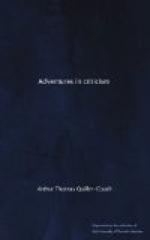A correction.
As a minor criticism, I may point out that the song, “Come, my Celia, let us prove ...” (included by Mr. Ebsworth, with the remark that “there is no external evidence to confirm the attribution of this song to Carew”) was written by Ben Jonson, and is to be found in Volpone, Act III., sc. 7, 1607.
But, with some imperfections, this is a sound edition—sadly needed—of one of the most brilliant lyrical writers of his time. It contains a charming portrait; and the editor’s enthusiasm, when it does not lead him too far, is also charming.
“ROBINSON CRUSOE”
April 13, 1895. Robinson Crusoe.
Many a book has produced a wide and beneficent effect and won a great reputation, and yet this effect and this reputation have been altogether wide of its author’s aim. Swift’s Gulliver is one example. As Mr. Birrell put it the other day, “Swift’s gospel of hatred, his testament of woe—his Gulliver, upon which he expended the treasures of his wit, and into which he instilled the concentrated essence of his rage—has become a child’s book, and has been read with wonder and delight by generations of innocents.”
How far is the tale a parable?
Generations of innocents in like manner have accepted Robinson Crusoe as a delightful tale about a castaway mariner, a story of adventure pure and simple, without sub-intention of any kind. But we know very well that Defoe in writing it intended a parable—a parable of his own life. In the first place, he distinctly affirms this in his preface to the Serious Reflections which form Part iii. of his great story:—
“As the design of everything is said to be first in the intention, and last in the execution, so I come now to acknowledge to my reader that the present work is not merely a product of the two first volumes, but the two first volumes may rather be called the product of this. The fable is always made for the moral, not the moral for the fable....”
He goes on to say that whereas “the envious and ill-disposed part of the world” have accused the story of being feigned, and “all a romance, formed and embellished by invention to impose upon the world,” he declares this objection to be an invention scandalous in design, and false in fact, and affirms that the story, “though allegorical, is also historical”; that it is




